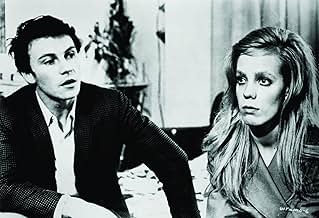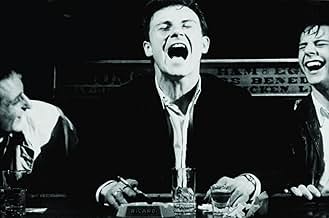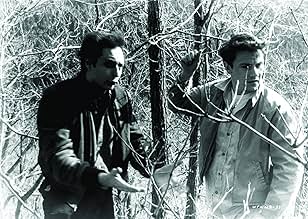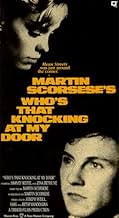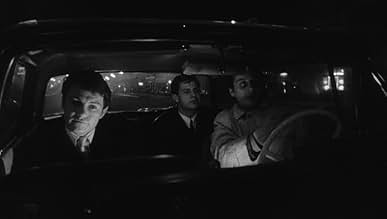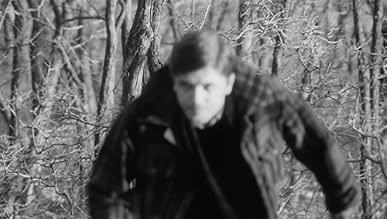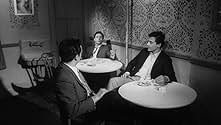ÉVALUATION IMDb
6,5/10
11 k
MA NOTE
Un jeune homme se débat avec le fait que sa petite amie a été victime d'un viol.Un jeune homme se débat avec le fait que sa petite amie a été victime d'un viol.Un jeune homme se débat avec le fait que sa petite amie a été victime d'un viol.
- Director
- Writers
- Stars
- Prix
- 1 nomination au total
Anne Collette
- Girl in Dream
- (as Ann Collette)
Philip Carlson
- Boy in Copake
- (as Phil Carlson)
Marrissa Joffre
- Girl at Party
- (as Marrisa Joffrey)
Victor Magnotta
- Boy in Fight
- (as Vic Magnotta)
Thomas Aiello
- Minor Role
- (uncredited)
Avis en vedette
"Who's That Knocking At My Door?" (1968) is the kind of film where you see it once you'll want to see it again, just to see what you didn't understand. The protagonist is played by Harvey Keitel as J.R., an autobiographical role based loosely on Scorsese's strict Catholic upbringing. And many symbolic Catholic references there are such as the Virgin Mary mini statue reflection in the mirror watching Harvey Keitel's JR as he embraces "The Young Girl" played by Zina Bethune.
Scorsese is so intelligent and inventive with his scenes here; crafty artsiness at its best (like the one where J.R. is having sex with the "broad" in a dream fantasy, but then afterwards flips his cards towards her rejecting her as a sin; she's not a nice virgin who would be a good wife and mother for J.R.; she's just a whore, a "broad", as we listen to The Doors' song 'The End' finish). Marty's own personal style was established in this early film.
Harvey Keitel was 29-years-old when Martin Scorsese's [who was 25] "Who's That Knocking At My Door?" debuted in 1968. This was a full-length feature debut for both actor Keitel and director Scorsese. It was interesting to see this for the first time recently after I had already seen most of Scorsese's later films. His classic trade marks such as the "freeze frame, slow-motion, and classic rock tracks playing on the soundtrack" are all utilized effectively in this early gem. ("Easy Rider" is always the film that is credited as being the originator of playing classic rock tunes on the soundtrack, but "Who's That Knocking At My Door?" wasn't seen by many until it received wide release in 1970, almost three years after it was made.)
For any film school student or aspiring director/screenwriter this is a must see. Mr. Scorsese financed this film on a tight budget. I read somewhere that his film professor from NYU helped him finance it. From the beginning somebody somewhere knew Marty had the talent and could make a good picture. He created a wonderful film; using his own life experience for the story he was able to concoct a great, interesting and personal film. His "Mean Streets" (1973) is a much greater and even more personal film. But "Who's That Knocking At My Door?" was the beginning.
I'm not Catholic but I certainly learn a lot about Catholicism when I watch a Scorsese flick. For instance, take the scene where "The Young Girl" is making dinner at J.R.'s place, she lights up what appears to be just a candle. But to J.R. it is a "Holy Candle" and makes her put it back and replace it with another one. There are many classic scenes in this film, but I don't want to spoil it for you.
Directed by Martin Scorsese. Edited By Thelma Schoonmaker (who would go on to edit almost all of Scorsese's later films). Starring Harvey Keitel as J.R. 90 minutes.
Scorsese is so intelligent and inventive with his scenes here; crafty artsiness at its best (like the one where J.R. is having sex with the "broad" in a dream fantasy, but then afterwards flips his cards towards her rejecting her as a sin; she's not a nice virgin who would be a good wife and mother for J.R.; she's just a whore, a "broad", as we listen to The Doors' song 'The End' finish). Marty's own personal style was established in this early film.
Harvey Keitel was 29-years-old when Martin Scorsese's [who was 25] "Who's That Knocking At My Door?" debuted in 1968. This was a full-length feature debut for both actor Keitel and director Scorsese. It was interesting to see this for the first time recently after I had already seen most of Scorsese's later films. His classic trade marks such as the "freeze frame, slow-motion, and classic rock tracks playing on the soundtrack" are all utilized effectively in this early gem. ("Easy Rider" is always the film that is credited as being the originator of playing classic rock tunes on the soundtrack, but "Who's That Knocking At My Door?" wasn't seen by many until it received wide release in 1970, almost three years after it was made.)
For any film school student or aspiring director/screenwriter this is a must see. Mr. Scorsese financed this film on a tight budget. I read somewhere that his film professor from NYU helped him finance it. From the beginning somebody somewhere knew Marty had the talent and could make a good picture. He created a wonderful film; using his own life experience for the story he was able to concoct a great, interesting and personal film. His "Mean Streets" (1973) is a much greater and even more personal film. But "Who's That Knocking At My Door?" was the beginning.
I'm not Catholic but I certainly learn a lot about Catholicism when I watch a Scorsese flick. For instance, take the scene where "The Young Girl" is making dinner at J.R.'s place, she lights up what appears to be just a candle. But to J.R. it is a "Holy Candle" and makes her put it back and replace it with another one. There are many classic scenes in this film, but I don't want to spoil it for you.
Directed by Martin Scorsese. Edited By Thelma Schoonmaker (who would go on to edit almost all of Scorsese's later films). Starring Harvey Keitel as J.R. 90 minutes.
A well-dressed but feckless young man (Harvey Keitel, in his acting debut) on the streets of New York meets a lovely single girl reading a foreign magazine and strikes up a conversation about movies; soon after, they begin dating, however she volunteers more about her past than he is able to handle. Striking if aimless debut from writer-director Martin Scorsese, alternately titled "I Call First", began life as a short feature from the young film student. His sexual montage, featuring Keitel and his 'broads' (and set to "The End" by the Doors), is a fabulous example of cinematic sound and fury: the perfect marriage between silvery black-and-white cinematography, kinetic editing, great music and lusty bodies. Unfortunately, Scorsese as a writer had not developed a true ear for canny dialogue, and the characters fail to emerge as a result. Still, an almost-dynamic first try, and a must-see for film historians. Keitel, marvelously youthful and muscular, is more callow than expressive, though he gives the picture its pulse; the cinematography from Richard Coll and Michael Wadley is a major asset as well. **1/2 from ****
Filmed over years apparently, this early M. Scorsese New York tale involving young dudes being typically out of it is interesting in the scenes with Keitel and the girl (Z. Bethune), but the buddy scenes tend to drag on and semi-bore. A 5 out of 10. Best performance = Zena Bethune.
Harvey Keitel has always been interesting and believable and it's great to see him in a lead (pre-MEAN STREETS) and Ms. Bethune is very touching and human. All Scorsese fans should track this down even though it's not that great. The DVD has a semi-commentary from Marty which is unusual! It comes in the recent DVD set of Martin Scorsese and worth a look! Harry Northrup has a small role (MEAN STREETS, TAXI DRIVER).
Harvey Keitel has always been interesting and believable and it's great to see him in a lead (pre-MEAN STREETS) and Ms. Bethune is very touching and human. All Scorsese fans should track this down even though it's not that great. The DVD has a semi-commentary from Marty which is unusual! It comes in the recent DVD set of Martin Scorsese and worth a look! Harry Northrup has a small role (MEAN STREETS, TAXI DRIVER).
Martin Scorsese is undoubtedly one of my all time favorite directors. He has a consistently great string of movies that span his entire career and Who's That Knocking at My Door is the very first one of them all. The movie itself is very good, but looking at it in relation to the career and development of Scorsese's aesthetically unique style of directing makes it even better. When you break it down it is sort of a movie about nothing, and it focuses more on aesthetics and visual nuances to give it a very unique feel that fits right in with Scorsese's body of work. But if you have to assign a storyline to the film it is about J.R., an Italian American living in New York, who meets a girl and falls in love with her. They have their ups and downs and the movie essentially just follows J.R. through his life as a city slicker, hanging out with his foul mouthed buddies at bars and trying to balance that with his love life. The story more or less takes a back seat to the unique visual exploration that is way ahead of its time.
If you're familiar with Scorsese, then this film would be what you would expect from his directorial debut. It is very raw, unpolished, and experimental. Thankfully, a lot of what Scorsese plays with in this film would actually carry through to his later films that were obviously much bigger successes. This film is essentially a gigantic lens into what would later develop into Scorsese's very specific style of directing. It mixes up a little bit of everything and almost feels like a rough mixing of all of Scorsese's unique visual elements that he has trademarked since then. Who's Knocking at My Door employs all kinds of techniques that we've grown to love from Scorsese. It deals out some long static shots, long tracking shots, and its fair share of strangely quick cuts. The dialouge has a very unpolished Scorsese-esquire cadence to it. It can't even compare to some of the dialouge of his later films, but you can definitely see the early formations of Scorsese's vulgar and quick paced dialouge.
You also have to give a lot of credit to Scorsese and the people who signed on to help him produce this film because of just how experimental the film was for a directorial debut. The film is far ahead of its time in content and style, and for Scorsese to take this risk with his very first film is something that is very respectable in any filmmaker. He didn't try to do anything on a large and flashy scale. Instead he creates a very small scale story with small scale characters and he does a surprising lot artistically with the little he has to work with. And it's also incredible that, to me at least, it works. Trying something so bizarre and different from conventional filmmaking styles of the time could easily crash and burn. But Scorsese pulls it off with his first film and makes something that is actually watchable.
Who's Knocking at My Door is a really good movie by itself, but it becomes so much more interesting when you put it in the context of Scorsese's body of work. When you do this, the film becomes a fascinating study of the beginnings of Scorsese, and for that I absolutely loved it. Being such a small scale movie without a lot of purely escapist entertainment value it's hard to recommend this film to just anybody, but if you are a Scorsese fan then it is a must see.
If you're familiar with Scorsese, then this film would be what you would expect from his directorial debut. It is very raw, unpolished, and experimental. Thankfully, a lot of what Scorsese plays with in this film would actually carry through to his later films that were obviously much bigger successes. This film is essentially a gigantic lens into what would later develop into Scorsese's very specific style of directing. It mixes up a little bit of everything and almost feels like a rough mixing of all of Scorsese's unique visual elements that he has trademarked since then. Who's Knocking at My Door employs all kinds of techniques that we've grown to love from Scorsese. It deals out some long static shots, long tracking shots, and its fair share of strangely quick cuts. The dialouge has a very unpolished Scorsese-esquire cadence to it. It can't even compare to some of the dialouge of his later films, but you can definitely see the early formations of Scorsese's vulgar and quick paced dialouge.
You also have to give a lot of credit to Scorsese and the people who signed on to help him produce this film because of just how experimental the film was for a directorial debut. The film is far ahead of its time in content and style, and for Scorsese to take this risk with his very first film is something that is very respectable in any filmmaker. He didn't try to do anything on a large and flashy scale. Instead he creates a very small scale story with small scale characters and he does a surprising lot artistically with the little he has to work with. And it's also incredible that, to me at least, it works. Trying something so bizarre and different from conventional filmmaking styles of the time could easily crash and burn. But Scorsese pulls it off with his first film and makes something that is actually watchable.
Who's Knocking at My Door is a really good movie by itself, but it becomes so much more interesting when you put it in the context of Scorsese's body of work. When you do this, the film becomes a fascinating study of the beginnings of Scorsese, and for that I absolutely loved it. Being such a small scale movie without a lot of purely escapist entertainment value it's hard to recommend this film to just anybody, but if you are a Scorsese fan then it is a must see.
This is a hard movie to review because it's essentially an amalgam of several different shorter student films, and some work better than others.
That said, at the crux of "Who's That Knocking at My Door" (the final mass-released version) is a complex character-study laden with Catholic guilt and burdened by all the inherent stigmas and traditions of growing up Italian-American.
Obviously Scorsece knew his source material very well. More than half of the players and virtually all the locations come straight from his own life. What's really cool about the film, though, is how honestly he portrays these sociological nuances. He doesn't tell you Keitel's character's views and attitudes are good or bad, they just "are" --- and it's obvious how the character developed them from a peek into his everyday world.
This bracing honesty is the most appealing thing about the film, along with some drop-dead gorgeous camera work and editing featured here. The first scene where Keitel meets Bethune on the ferry has got to be one of the most imaginatively-shot and enthrallingly staged boy-meets-girl moments on celluloid. Throughout the film, Scorcese overlays soundless scenes from the past and future, creating interesting juxtapositions, always engaging and challenging your perceptions.
With a lot of debuts there are missteps. I don't think that fairly characterizes this movie however. There are definitely parts that drag and don't work well but seen in the context of a shorter film, they would have been more effective. As they're all blended together here, the pacing sometimes suffers.
It's hard to imagine any of the fans of Scorsece's later works, which rely so heavily on hyper-real camera-work and tightly-structured story lines, to have the patience for "Who's That Knocking." But for those who really enjoy the thoughtfulness, subversiveness, and subtext of Scorcese's films, it's a treat to see their origins so prominently displayed.
That said, at the crux of "Who's That Knocking at My Door" (the final mass-released version) is a complex character-study laden with Catholic guilt and burdened by all the inherent stigmas and traditions of growing up Italian-American.
Obviously Scorsece knew his source material very well. More than half of the players and virtually all the locations come straight from his own life. What's really cool about the film, though, is how honestly he portrays these sociological nuances. He doesn't tell you Keitel's character's views and attitudes are good or bad, they just "are" --- and it's obvious how the character developed them from a peek into his everyday world.
This bracing honesty is the most appealing thing about the film, along with some drop-dead gorgeous camera work and editing featured here. The first scene where Keitel meets Bethune on the ferry has got to be one of the most imaginatively-shot and enthrallingly staged boy-meets-girl moments on celluloid. Throughout the film, Scorcese overlays soundless scenes from the past and future, creating interesting juxtapositions, always engaging and challenging your perceptions.
With a lot of debuts there are missteps. I don't think that fairly characterizes this movie however. There are definitely parts that drag and don't work well but seen in the context of a shorter film, they would have been more effective. As they're all blended together here, the pacing sometimes suffers.
It's hard to imagine any of the fans of Scorsece's later works, which rely so heavily on hyper-real camera-work and tightly-structured story lines, to have the patience for "Who's That Knocking." But for those who really enjoy the thoughtfulness, subversiveness, and subtext of Scorcese's films, it's a treat to see their origins so prominently displayed.
What Scorsese Film Ranks Highest on IMDb?
What Scorsese Film Ranks Highest on IMDb?
Cinema legend Martin Scorsese has directed some of the most acclaimed films of all time. See how IMDb users rank all of his feature films as director.
Le saviez-vous
- AnecdotesIn order to get distribution for his film, Martin Scorsese was told to add nude scenes so it could be promoted as a "sexploitation" movie. He thus shot the fantasy scene showing J.R. imagining encounters with prostitutes.
- GaffesMartin Scorsese utilizes the black and white nature of film to hide the lack of time and day continuity in some scenes.
- Générique farfeluThere is a big "Thanks to the County and City of New York" in the end credits.
- Autres versionsEarly versions of this film were screened without the erotic fantasy scene.
- ConnexionsFeatured in A Decade Under the Influence (2003)
- Bandes originalesJenny Take a Ride
(uncredited)
Written by Bob Crewe, Enotris Johnson, and Little Richard
Performed by Mitch Ryder & The Detroit Wheels
Meilleurs choix
Connectez-vous pour évaluer et surveiller les recommandations personnalisées
Détails
- Date de sortie
- Pays d’origine
- Sites officiels
- Langue
- Aussi connu sous le nom de
- Who's That Knocking at My Door
- Lieux de tournage
- Amsterdam, Noord-Holland, Pays-Bas(as New York, only interior, scenes with nudity)
- sociétés de production
- Consultez plus de crédits d'entreprise sur IMDbPro
Box-office
- Budget
- 75 000 $ US (estimation)
- Brut – à l'échelle mondiale
- 16 085 $ US
- Durée1 heure 30 minutes
- Couleur
- Mixage
- Rapport de forme
- 1.85 : 1
Contribuer à cette page
Suggérer une modification ou ajouter du contenu manquant

Lacune principale
By what name was I Call First (1967) officially released in India in Hindi?
Répondre
